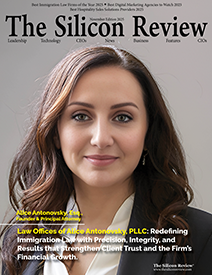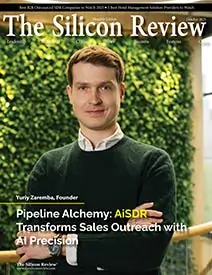>>
Industry>>
Space>>
Donald Roy Pettit, An American...Donald Roy Pettit, An American Astronaut, Spent 220 Days In Space!
The Silicon Review
23 April, 2025
On a crisp morning in Kazakhstan, a Soyuz capsule pierced the Earth’s atmosphere, carrying a man whose story defies conventional limits. Inside was Donald Roy Pettit, NASA’s oldest active astronaut, who had just completed a 220-day mission aboard the International Space Station (ISS). The date? His 70th birthday. This extraordinary homecoming marked not just a personal milestone but a testament to human resilience and curiosity. When the Soyuz MS-25 spacecraft touched down on September 7, 2024, it concluded one of the most poetic missions in space history. Donald Roy Pettit, alongside Russian cosmonauts Alexey Ovchinin and Ivan Vagner, emerged from the capsule with a grin that spoke volumes. For Pettit, this landing was more than a return—it was a celebration of life, science, and the audacity to explore. The mission, which began in February 2024, saw Pettit contribute to over 30 experiments, from studying microgravity’s effects on materials to advancing atmospheric spectroscopy techniques. His return coincided with a birthday that most would associate with retirement, yet Pettit’s career is anything but ordinary. Born in Silverton, Oregon, Donald Roy Pettit earned a Doctorate in Chemical Engineering from the University of Arizona in 1983. Before joining NASA, he worked as a staff scientist at Los Alamos National Laboratory, where his research on colloidal systems and fluid dynamics caught the agency’s attention. Selected as a NASA astronaut in 1996, Pettit quickly became known for his inventive spirit. During his first ISS expedition in 2002-2003, he crafted makeshift tools using available materials, earning him the nickname “MacGyver of Space.” Over two decades, he logged 370 days in space across three missions, solidifying his status as a veteran astronaut.
A Historic Homecoming for Donald Roy Pettit: Science, Age, and Triumph
When the Soyuz MS-25 spacecraft touched down on September 7, 2024, it concluded one of the most poetic missions in space history. Donald Roy Pettit, alongside Russian cosmonauts Alexey Ovchinin and Ivan Vagner, emerged from the capsule with a grin that spoke volumes. For Pettit, this landing transcended a routine return—it was a celebration of life, science, and humanity’s unyielding thirst for discovery. The mission, launched in February 2024, spanned 220 days and included over 30 experiments, from studying microgravity’s effects on plant growth to refining atmospheric spectroscopy tools for climate modeling. Notably, Pettit’s return coincided with his 70th birthday, a milestone many associate with retirement. Yet, for this trailblazer, it symbolized a defiance of earthly constraints. Post-landing, he quipped, “Gravity is a harsh mistress, but she’s no match for curiosity.” The crew’s data, stored in the Soyuz’s landing craft utility systems, promises insights into long-duration spaceflight’s physiological impacts, critical for future Mars missions.
The Journey of Donald Roy Pettit: From Chemist to Cosmic Explorer
A Foundation in Science: Bridging Molecules and Microgravity
Born in Silverton, Oregon, Donald Roy Pettit earned a Doctorate in Chemical Engineering from the University of Arizona in 1983. His early career at Los Alamos National Laboratory focused on colloidal systems—a niche that later informed his space experiments. Studying fluid dynamics in zero gravity, Pettit realized that Earth-bound physics couldn’t fully explain cosmic phenomena. His research caught NASA’s eye, leading to his selection as an astronaut in 1996. Before his space career, he authored papers on crystallography and combustion, foreshadowing his innovative approach to extraterrestrial problem-solving.
NASA’s “Space Grandpa”: The MacGyver of Orbit
Dubbed “Space Grandpa” by colleagues, Pettit became legendary for his ingenuity. During his 2002-2003 ISS expedition, he crafted a coffee cup from laminated plastic and Velcro, defying NASA’s reliance on sealed pouches. This “zero-g barista” moment epitomized his ethos: simplicity fuels discovery. Over 370 days in space across three missions, he repaired equipment with duct tape, photographed Earth’s auroras for atmospheric spectroscopy studies, and even grew zucchini in orbit. His playful yet profound experiments—like spinning water droplets to simulate planetary rings—inspired a generation of scientists.
Donald Roy Pettit’s Contributions to Space Science: Beyond n Boundaries
Innovating in Microgravity: The Art of Cosmic Observation
Pettit’s work in atmospheric spectroscopy revolutionized how we study planetary atmospheres. Aboard the ISS, he designed a handheld spectrometer to analyze noctilucent clouds, revealing clues about climate change. His time-lapse photography of auroras—captured during sleepless nights—provided unprecedented data on solar wind interactions. These experiments, conducted in the station’s Cupola module, blended art and science, proving that observation is as vital as experimentation in unraveling cosmic mysteries.
The “Coffee Cup” Experiment: A Sip of Genius
In 2008, Pettit’s “Coffee Cup” experiment became a viral sensation. Using a folded plastic sheet and capillary action, he demonstrated fluid dynamics in microgravity, challenging textbook models. This low-cost innovation informed designs for fuel tanks in NASA’s Space Launch System, ensuring stable liquid flow during deep-space maneuvers. Pettit later reflected, “Sometimes, the universe’s secrets hide in a drop of coffee.”
Breaking Barriers: Donald Roy Pettit as NASA’s Oldest Astronaut
Age is Orbit: Redefining Longevity in Space
At 70, Donald Roy Pettit shattered stereotypes about aging and capability. His mission underscored NASA’s shift toward valuing experience over youth. Rigorous physical tests at the Johnson Space Center—including underwater simulations and centrifuge spins—proved his readiness. “Age brings patience,” he noted, “and patience solves problems faster than brute strength.” His success paves the way for older astronauts to join lunar and Mars missions, where wisdom may outweigh athleticism.
Training at the Johnson Space Center: Mastering the Soyuz
Pettit’s training included mastering the Soyuz spacecraft model, a relic of Cold War-era engineering. Collaborating with Russian cosmonauts, he rehearsed emergency dockings and re-entry protocols, emphasizing cross-cultural teamwork. “The Soyuz is like a vintage car,” he joked. “It’s quirky, but it gets you home.” His fluency in Russian and respect for Roscosmos protocols strengthened international ties amid terrestrial geopolitics.
The Soyuz Capsule and International Collaboration: Unity in Orbit
Docking at the Rassvet Module: Gateway to Discovery
The ISS’s Rassvet module, a Russian-built docking port, welcomed Pettit’s crew in February 2024. Their arrival marked the start of a mission upgrading life support systems and studying bone density loss in microgravity. Rassvet, meaning “dawn” in Russian, symbolized Pettit’s role in bridging NASA’s past and future—honoring Apollo-era ideals while advancing Artemis-era ambitions.
A Symbol of Unity: The Soyuz Legacy
The Soyuz capsule, a hallmark of Russia’s space program, has ferried astronauts for decades. Pettit’s journey highlighted its enduring reliability and the quiet diplomacy of shared missions. “In space, nationality fades,” he said. “You’re just humans clinging to a tiny ship in an infinite ocean.”
The Legacy of Donald Roy Pettit: Inspiring tomorrow’s Explorers
Mentoring the Next Generation: Poets and Engineers
As a mentor for NASA’s Space Exploration Initiative, Pettit blends poetry with pragmatism. His essays, like “The Tyranny of the Rocket Equation,” are required reading for young engineers. He urges protégés to “think like explorers, not tourists,” emphasizing curiosity-driven science over checkbox milestones.
Pioneering Lunar and Mars Missions: From Soil to Stars
Pettit’s research on extracting water from lunar regolith aligns with Artemis’s goal of sustainable moon bases. His experiments with hydroponic zucchini aboard the ISS inform plans for Martian greenhouses. “The first lettuce grown on Mars,” he predicts, “will taste like victory.”
Celebrating Donald Roy Pettit: A Birthday among the Stars
The ISS crew marked Pettit’s 70th with a zero-gravity cake and a video message from his grandchildren. Floating candles, crafted from foil and wire, flickered in the station’s airflow. “Birthdays in space remind you that time are relative,” he mused. “But cake is universal.”
Conclusion: A Cosmic Trailblazer’s Infinite Horizon
Donald Roy Pettit’s 220-day mission transcends records—it’s a saga of grit, wonder, and reimagined possibilities. From colloidal chemistry to cosmic photography, he reshaped space science. As he advises NASA’s next-gen missions, his legacy orbits eternally: a beacon for those who dare to explore, regardless of age or gravity.


_2025-11-17_06-38-14.webp)

 (1)_2025-10-21_13-35-14.webp)

_2025-10-02_10-21-48.webp)